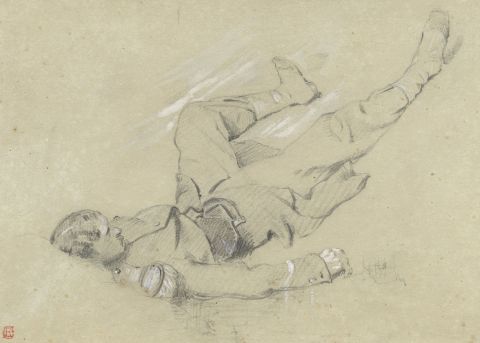This website uses cookies to ensure you get the best experience on our website. Learn more.
Ernest Crofts RA, Fallen Soldier Study – Late 19th-century graphite drawing
Collection: Ernest Crofts RA 1847–1911
An original late 19th-century graphite drawing, Ernest Crofts RA, Fallen Soldier Study.
A sensitive and poignant original pencil sketch by one of the leading military-historical painters of the late Victorian and Edwardian periods, Ernest Crofts RA (1847–1911). Likely preparatory material for the artist's highly detailed works in oil, this drawing shows not only Crofts's fine draughtsmanship, but also his intimate knowledge of military costume and his meticulous attention to detail. Unlike many of his contemporaries, Ernest Crofts brought to his art direct witness of the battlefield, having in 1864 accompanied a Prussian doctor in the Schleswig-Holstein War and in 1870–1 witnessed first-hand the closing stages of the Franco-Prussian war, at Weissenbourg, Wörth, and the siege of Strasbourg.
Provenance: Studio Sale, Christie's, Dec 18th 1911.
In graphite with white bodycolour highlights. On pale grey paper.
All artworks come with a Certificate of Authenticity and—if it is a collection artwork—its accompanying collection text or artist biography.
Details
Signed: Signed with monogram stamp lower left.
Condition: Some minor, small scattered spots of foxing and slight age toning. There is a short repaired tear to the lower edge. Please see photos for detail.
Presented: Unframed.
Ernest Crofts RA 1847–1911
This drawing is one of a fine collection of works that we have for sale by Ernest Crofts RA (1847–1911). The works, all military-historical figure studies, show the focus on incident and person which would come to characterise military art in the second half of the 19th century, moving away from the sweeping panoramic battle scenes of the early 19th century. Crofts favoured historical subjects of the Napoleonic era and English Civil War—the distance of time giving space to glorify events. His paintings, which shared much of the Romanticism of the French school, tell us much about late Victorian attitudes to war and history, and the widely held belief that the British Empire had a 'mighty mission' to defend 'rational freedom' (W.E. Gladstone). In these drawings, however, we can also see the care taken by Crofts to depict the humanity behind warfare: these soldiers are individuals, seen in quiet moments—at rest, administering care and fallen—rather than just numbers in the field. Crofts also had an outstanding knowledge of military costumes and accoutrements, rendering these in minute detail and bringing authenticity to his work. He himself built up a large collection of original uniforms and accessories, many of which were exhibited at the Royal Military Exhibition held at Chelsea Hospital in 1890. Crofts was born into a prosperous family in Leeds: his father John Crofts, Esq. of Adel, near Leeds, a Justice of the Peace and his mother was the daughter of a Leeds industrialist. After studying at Rugby school, it was during a trip to Berlin that his interest in art developed. In 1870, Crofts moved to Dusseldorf to study under the German military artist, Emile Hünten (1827–1902), who in his turn had studied under Hippolyte Flandrin and Horace Vernet at the Ecole des Beaux Arts. Crofts accompanied Hünten on various battlefields during the Prussian war with France and was present at the battle of Gravelotte, an episode he represented in a painting 'Retreat', exhibited in 1874. While contributing to the annual Royal Academy exhibition, he continued to live in Düsseldorf where he met his future wife, Elizabeth Wüsthofen. Crofts then turned his attention to historical military subjects, exhibiting twelve paintings at the Royal Academy between 1875 and 1906 representing the events surrounding the Waterloo campaign. His first notable pictures of the English Civil War were exhibited in 1877, one of which depicted Oliver Cromwell at Marston Moor. In the same year, he refused the offer of an appointment of military painter to the Prince of Romania to be attached to his staff during the Russo-Turkish War. After almost ten years in Germany, Crofts returned to England to study with the historical genre painter Alfred Barron Clay (1831–1868). He was elected an Associate of the RA in 1878 and a full academician in 1896, the only late 19th-century military artist to achieve this honour. Two years later he was appointed keeper and trustee of the RA, giving him accommodation at Burlington House, a role that he excelled in due to what were reportedly his 'pleasant manner, his good looks, and his amiability of character'.
View the full collection Ernest Crofts RA 1847–1911




